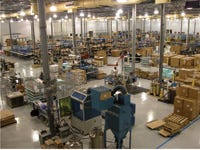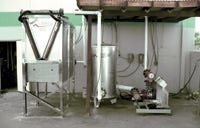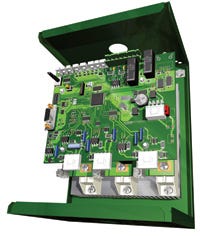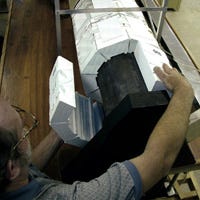Bright ideas light the path to energy efficiency
The majority of energy costs in a molding facility go toward polymer processing, but aside from investing in new energy-efficient machinery, there are other ways, as well as plenty of available incentives, to cut costs and usage.
April 9, 2009
The majority of energy costs in a molding facility go toward polymer processing, but aside from investing in new energy-efficient machinery, there are other ways, as well as plenty of available incentives, to cut costs and usage.
Rising energy costs are a concern all around the world, and the deal your company thought it was getting on going with the standard model instead of the energy-efficient one has been haunting you for years now. Plus, despite a hefty economic stimulus package, the banks aren’t lending money like they used to, especially in the manufacturing sector.
|
Sound like a familiar predicament? While it’s true that you often have to spend a little to save a lot, some efficiency tips cost nothing but a few minutes of your time. And there are many ways to increase energy efficiency and decrease utility bills that give a quick return on investment, especially with all the rebates and incentives available, depending on the state. Here are some of the latest ideas in energy efficiency, with some examples of how molders have seen significant results.
Better, brighter bulbs
In addition to primary processing machinery energy costs, the lighting, heating, and cooling energy required to operate a facility form a huge cost factor. Unless we’re talking about automated, fully lights-out manufacturing, proper lighting in a molding facility is essential for safety and productivity. But lighting a big space can use up a lot of electricity, not to mention generate a lot of heat.
Mack Molding (Arlington, VT) found a way to reduce operating costs, save a significant amount of electricity, and improve working conditions for employees. The installation of more than 2100 energy-efficient lighting fixtures in the company’s southern Vermont manufacturing facilities is one of the 10 largest energy-saving projects completed by any Vermont company in partnership with Efficiency Vermont, with the project generating enough energy savings to power the equivalent of 300 homes in the Green Mountain State.
To improve the level and quality of light while minimizing maintenance, the new lighting in 600,000 ft2 across three facilities cost nearly $450,000. Technical assistance and a financial incentive were provided by Efficiency Vermont, the organization created by the state’s legislature and the Vermont Public Service Board to help reduce energy costs. The new fixtures, some with motion sensors, improved light levels by 175% in a warehouse with 30-ft ceilings, while resulting in a total projected electricity savings of 1.747 million kWh per year.
An added benefit for workers is lower operating temperatures, which means less cooling and ventilation during the warm summer months. “I’m out on the manufacturing floor for most of the day,” says Bonnie Simon, manufacturing manager at Mack’s Arlington HQ. “I can’t help but notice that my eyes are much less fatigued by the end of the day. The glare is gone, leaving us with even lighting everywhere.”
Water wonders
With an estimated two-thirds of the energy a facility consumes being used in polymer processing, and another 11% for chillers and 10% for compressors, there are many areas for improvement that can lead to big savings. The extreme and varied heat required in several steps of the molding process can make the amount of energy needed to cool things back down add up. Until recently, different cooling units needed to be purchased to handle high- or low-temperature-range applications in many instances.
At Fakuma 2008 last fall, a system capable of covering operating temperatures from 68-320°F in one heating and cooling unit was introduced by Wittmann Battenfeld (Torrington, CT). The Duo cooling feature on the company’s Tempro Plus C line of temperature controls allows for a rapid total exchange of process water in the system, using indirect cooling for higher temperatures of 200-320°F where less energy dissipation is required by the mold. For high-load, low-temperature applications ranging from 68-200°F, the unit switches automatically to direct cooling, where warm water is transported from the mold cooling circuit to the cooling water drain, and cooling water flows directly into the heat exchanger. In addition to reduced cooling energy costs and unit acquisition costs, the system has resulted in cycle time reductions, which in turn reduces energy needed in other areas of processing.
One Southern California moldmaker and molder found a system that not only decreases energy usage, but also provides a drastic reduction in water usage. When the Santa Ana winds start blowing, sand from the desert would contaminate the water in traditional cooling towers at Superior Mold Co. (Ontario, CA), resulting in constant maintenance requirements. Superior installed a two-fan, 30-ton Ecodry closed-loop cooling system from Frigel (East Dundee, IL). The system is projected to reduce Superior’s water usage by 90% and energy usage by 60%, with the energy savings audited and verified by a third-party energy consultant. In California, this resulted in a 30% rebate check for the cost of the system. Steve Petrakis, president of Frigel North America, mentions that, depending on the system size and the area of the country, Frigel customers typically see from 30-40% of the initial cost come back as a rebate. A system can start small and easily be expanded to systems in excess of 60 fans with 1000-ton capacities.
“Clean water and water savings is a big part of what drives customers to our technology,” says Petrakis. “The clean water aspect cuts total system maintenance time to a minimum, including molding machines, while water savings over a conventional open-loop tower system can be up to 95%, depending on climate.” And since Superior is an ISO-certified supplier with a device manufacturing license from the State of California, having clean water throughout the facility is even more crucial.
“The system allows us to circulate clean water to our molding machines with no chemical treatment—a big requirement for our Class 100,000 cleanroom,” says Tony Codet, president of Superior Mold. “This also plays a part in our Six Sigma commitment as well as in meeting our ambitious process improvement goals.”
Getting the most out of motors
Robin Kent has been providing energy savings tips to molders through his consulting firm Tangram Technology Ltd. (Hitchin, England), recently giving advice to the attendees at the Sustain ’08 plastics business summit last November in Chicago. Of the total plastics processing energy costs, he says approximately two-thirds are the result of electric motor usage, and though it is easy to be aware of motor efficiency in main processing equipment, Kent notes that the energy used in fan, pump, and compressor motors adds up quickly.
The purchase cost of a motor can be exceeded by the energy operating costs in as few as 1000 hours, so the small cost premium for high-efficiency motors quickly offsets the energy costs. These high-efficiency motors are up to 3% more efficient than conventional motors and have a peak efficiency at 75% of load. Using larger-than-required motors will prevent motors from reaching their rated capacity, and motors are most efficient when their load equals this rated capacity. Repairing failed motors can reduce energy efficiency by up to 1%, so though it might initially be a cost-effective action, it would likely be less expensive in the long run to replace the failed motor with a more efficient one, says Kent. Fitting fixed-speed conventional AC motors with a variable-speed drive allows the speed to match varying demand, which can significantly reduce cost.
To help make motors as efficient as possible, Power Efficiency Corp. (Las Vegas, NV) developed E-save technology, which uses a microprocessor and circuitry to sense the energy requirements of a motor. The voltage and current being fed to the motor are monitored and the motor is provided with the exact amount of energy that it needs. Thus the motor can maintain its rated speed and torque under variable loads.
At the Graham Packaging plant in Henderson, NV, a 50-hp motor efficiency control was installed on a granulator motor. Compared to the prior kilowatt usage and power factor data collected, E-save reduced the required kilowatts by more than 37%. Over the expected granulator product life of 15 years, this translates to 281,880 kWh saved, which amounts to $23,955, based on a modest projection of 5% annual increase in power costs. (More information can be found on this technology here.)
Ask an expert
Business is changing, and it can be difficult to find the time to be informed about energy-saving developments, but there is an increasing number of energy experts who can evaluate and recommend changes for a specific operation. A good consultant should be able to look at your situation objectively and identify and implement the solution to the problem more quickly and efficiently than you or your staff could. And as this becomes an increasingly important topic, more experts are emerging with knowledge specific to the needs of plastics manufacturing.
Formed to use the knowledge and experience of its management and technical team to help clients reduce energy costs, the current owners of Absolute Haitian Corp. and Absolute Machinery Corp. (Worcester, MA) Mike Ortolano, Nathan Smith, and Glenn Frohring announced the launch of Absolute Green Energy Corp. in February. This newly formed organization offers products and services to help clients reduce energy costs, including energy audit services and supplemental systems, solar photovoltaic renewable energy systems, and solar thermal weather and space heating systems. So far, the core focus of the company has been to help the plastics processing community, and the company recently hired Fred Charpentier as the VP of sales and marketing, whose 25-year tenure in the plastics industry will contribute to this market while expanding into renewable energy systems with a broader market reach.
“Our customer base is very strongly slanted at this stage of the game towards the injection molding and processing community,” says Charpentier. “The power factor correction has been getting a lot of interest. We’re working on new projects, but we’re focused on helping our core customers be more efficient.” —[email protected]
WEB EXCLUSIVE
Part II
Heat in a hurry
In a manufacturing process like injection molding that requires precise control of heating and cooling, it can be difficult to efficiently direct heat to where it’s needed without a good portion escaping into the facility. To help efficiently keep barrel temperatures in control to within ±1 deg F, Milacron (Batavia, OH) developed the Servtek Thermal Control Solutions (TCS) system, which is said to offer up to 70% energy savings over conventional heater bands. Using a radiant heating element embedded in high-temperature Pyrolite ceramic insulation, the energy released from the exposed element is directed into the barrel, regardless of good barrel contact. Unlike ceramic heater bands, aluminum-finned cast heaters, and water-cooled heaters that must heat themselves up before conducting heat into the barrel, the TCS transfers heat immediately, resulting in up to 55% faster warm-up time, and is also able to start cooling instantly without first cooling a band heater.
|
The system allows the heat to be released into the plant in the winter and vented outside in the summer, decreasing heating and air-conditioning costs and increasing operator safety and comfort. State rebates, credits, and incentives may be available to cover more than 50% of the Servtek TCS installed cost, and the energy and maintenance savings, improved response time, and increased productivity provided by this system have shown an ROI of less than a year.
Save on compressed air and compensation
Compressed air can be one of the biggest energy wasters in a production facility, with Kent estimating that 40% of generated compressed air is lost in leaks. And with a 10-year operating life of a typical 100-kW compressor costing more than seven times its original capital cost to run, investing in an energy-efficient system is cost effective. But even without spending money on new equipment, Kent believes that simply by making employees aware of the high cost of compressed air and encouraging them to report leaks, energy savings up to 30% can be achieved. With some soapy water, a brush, and a careful ear, most leaks can be detected, or an ultrasonic detector can be purchased for more accurate leak detection.
It might be increasingly difficult to find the money to invest in new energy-efficient molding machines, but there are energy-saving ideas that go beyond staggering startups and switching off heaters, cooling water, and compressed air to idle machines. The reactive load of any machine puts an extra load on the overhead lines, transformers, and power stations of the energy supplier’s power grid, so compensation equipment has been created for installation in the main distribution center of a manufacturing facility. This requires that the reactive power on the production floor be taken into account when planning the capacity of the company’s internal energy transfer network. With injection molding machines, low energy periods and performance peaks alternate in a quick succession, so conventional reactive load compensation systems haven’t been a suitable option.
A system called EcoPower, demonstrated on a machine at Fakuma 2008 last October by Wittmann Battenfeld (Torrington, CT) uses low-maintenance semiconductor switches to activate a varying number of compensation levels, depending on the size of the drive unit. Depending on the kilowatts of the main motor, investment for the system is $2000-$7000—an investment that is amortized over one to two years. This system is particularly effective in hydraulic machines, and effective power-reduction units up to 37 kW have a soft-startup integrated function. The dimension of the power supply installation required on the production floor can be downsized by reactive power compensation on the machine, and more incentives are being offered for this optimized compensation.
Just as part designers are starting to be asked to provide the carbon footprint associated with a product over its lifespan, the full life-cost of any piece of equipment, which includes the initial and operating costs, is essential. Look beyond the length of time that the company will be paid back and factor in the cash flow over the equipment life to find products with the greatest benefit. Rising energy costs should be factored in as well. —[email protected]
Are you familiar with the terms listed below? The first step to finding energy savings is to know where you stand, and there are numerous tools and tips available online. For information on improving power factor, for example, check out the whitepaper posted here from Staco Energy Products Co. (Dayton, OH). Energy-tracking tips and terminology Base load: energy used for heating, lighting, compressors, and pumps with no production happening. Specific Energy Consumption (SEC): the amount of energy used per kilogram of good finished product. Maximum power requirement: maximum current that can be drawn at the supply voltage without tripping circuit breakers. Maximum demand: peak current drawn at the supply voltage generally measured over every half hour. Power factor: Measure of the phase shift created by machinery. Load factor: measure of the hours per day that energy is used. |
About the Author(s)
You May Also Like







